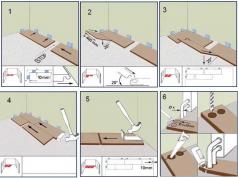Various factors lead to tooth wear. They are destroyed. Both banal caries and all kinds of injuries lead to this. Some diseases also provoke tooth decay. And what to do? Fortunately, modern technologies and materials allow you to fully restore lost functions. In order to strengthen the damaged unit, crowns are put on the teeth. How are they set? What are they like? Which ones to choose? You will find answers to these and other questions in this article.
What are crowns and bridges?
A structure covering a completely decayed tooth is called a crown. It is fixed with special cement. Its function is not only to strengthen and protect the jaw arch unit. With the help of crowns, even the shape of the tooth is changed. But today the aesthetic aspect is very important for many patients.
A bridge is a structure that replaces missing teeth in the jaw arch. If the patient is missing at least one unit, then it can be restored by implantation. But this method has been used relatively recently in the post-Soviet space and is considered expensive. But prosthetics with the help of bridge structures have been used for a long time. And this method is available to every patient. The cost of the service will depend on the materials used in the manufacture of the bridge. Next, we will talk about which crowns are placed on the teeth.
Kinds
Crowns are divided according to several principles.
The first is when products are distinguished depending on the purpose of the design. They are supporting and restorative.
The second principle divides orthodontic products according to the types of material from which they are made (metal, non-metal, mixed).
Products are distinguished by the principle of their design. There are full crowns that cover the entire tooth. There are also so-called half-crowns. These products do not cover the back of the jaw arch unit.
For the splinting procedure, equatorial structures are made. This is a kind of strip covering the tooth in a circle.
To restore severely damaged units, stump crowns are made on the teeth. How are they set? The doctor performs them so that the edges of the product deepen under the edge of the gum.
Also, in cases where the unit is significantly destroyed, crowns with a pin are installed. This allows you to create additional support.
To select the height of the product directly on the tooth itself, telescopic structures were created.

Installation process
So, what do you need to know if you are going to restore a unit with a crown? How are they placed on the teeth? Let's consider the whole process.
1. The most important step is the preparation of teeth for prosthetics. If necessary, the dentist performs filling, removal of tartar, depulpation. Next, the tooth must be ground. Depending on the selected material for the structure will be removed upper layer a certain thickness (1.5-2 mm). If the nerve has not been removed in the unit, then the doctor uses anesthesia during the preparation. It will allow you to carry out all the manipulations without causing much discomfort to the patient.
2. When the grinding is completed, the moment comes for taking casts of the jaw. The specialist does this with plaster.
3. Casts are handed over to the dental technician. And he is already making a crown.
4. Then the patient is invited to try on the design. The doctor marks the areas that need to be corrected.
5. After the crown is finally ready, the specialist puts it on the turned tooth with a special glue.
In cases where it is planned to install structures made of ceramic, zirconium dioxide, the specialist offers a plastic crown for the time of manufacture (the process may take several weeks). So a person can lead a full life.
Sometimes patients ask the question: "Is it possible to put a crown - the tooth is almost destroyed?" To date, technology allows you to restore any unit. If the condition of the root is satisfactory, the doctor puts the crown on pins that serve as additional support. Or use special tabs that mimic the lost part of the tooth.
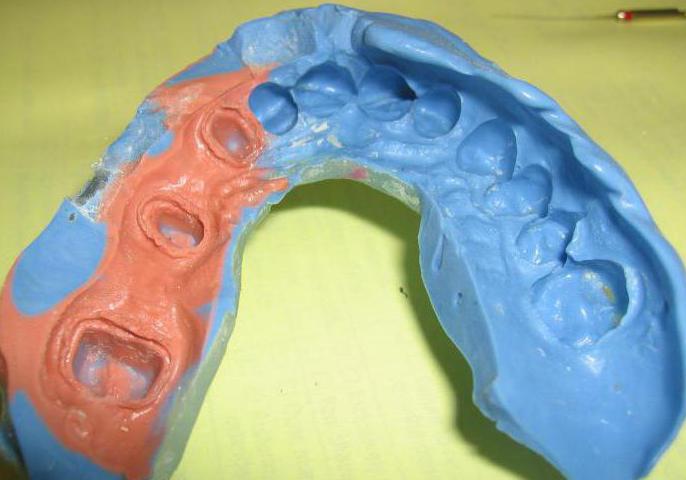
Crowns made of metal
Despite the fact that dentistry is developing very quickly today, orthopedists note that metal crowns are still in demand among patients. When the question arises which crowns to put on chewing teeth, the doctor may recommend designs made of gold alloy.
They are not suitable for the frontal area, as they will violate the aesthetics of the smile. But on the side units that are not visible, they can be installed. The advantage of the material is the relative softness. This allows for a perfect fit of the crown walls to the turned tooth. Also, this factor favorably affects the preservation of the enamel of neighboring units. Gold wears out at almost the same rate as enamel. This protects it from premature erasure. Well, a crown made of metal perfectly copes with the load exerted when chewing food. Such products do not chip. They rarely break at all.
Reviews of specialists and patients
The opinion of doctors here is ambiguous. Some believe that metal crowns will still be in demand a long period. Experts note that the designs have earned their popularity with such qualities as strength and affordability.
Other experts argue that only modern materials and technologies for prosthetics should be used. To date, patients also respond ambiguously about metal crowns. Many people remove them to replace them with products that will match the color of their natural teeth.
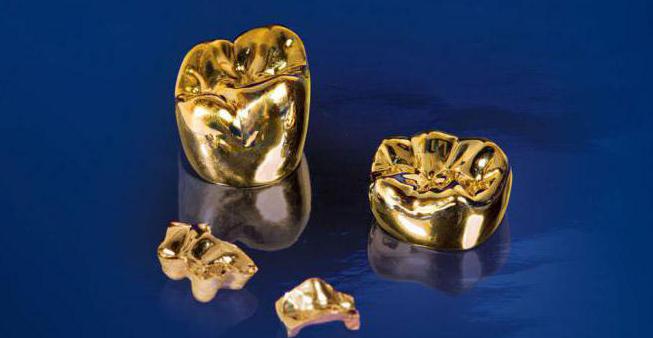
Plastic products
Typically, such structures are made for temporary use. But they are also suitable for permanent use. Plastic crowns mimic natural teeth well. They can be quickly made, which is quite convenient. They are usually placed on the frontal region of the jaw. They are not able to withstand a large load. Therefore, they are placed on the side sections only for a while, while a permanent prosthesis is being made.
Reviews
Plastic crowns are different democratic price. This makes them accessible to all segments of the population. However, they have a number of disadvantages.
1. They change color over time.
2. Not strong enough.
3. Require more maintenance than other designs. This is due to the porous structure of the plastic. Pathogenic bacteria quickly accumulate in the material.
4. In some patients, plastic causes allergic reactions.
5. Short service life.
At the same time, experts note the advantages of the material. When the patient asks which crowns to put on the front teeth so that it is inexpensive, the specialist will recommend plastic constructions. If there are no contraindications and the patient is not allergic, they will fit perfectly into the smile. With proper care, crowns should last 5 years. And according to patient reviews, such structures can stand for much longer.
Ceramics
To achieve the similarity of crowns with natural teeth, they began to be made of porcelain and other ceramic materials. These products are highly aesthetic. The material has a translucent property. And this allows you to make a design that, even at close range, cannot be distinguished from the patient's native teeth.
However, ceramics also has its drawbacks. The material is inferior in strength to metal alloys. Therefore, when asked which crowns are placed on the teeth in front, a specialist can recommend all-ceramic products. They will not spoil, and in some cases even significantly improve the aesthetics of the patient's smile. At the same time, the load during chewing is distributed in such a way that the frontal zones get a “gentle mode”. Here, ceramics can last up to 15 years with proper care.
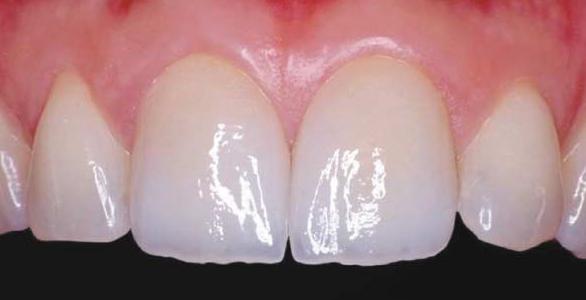
What are the best crowns for teeth? Reviews about ceramics
Undoubtedly, the material is considered progressive in the field of dentistry. Pressed porcelain crowns look great. In this aspect, the opinion of specialists does not differ from the reviews of patients. Aesthetics of a smile - on top. However, porcelain is inferior in strength to zirconium dioxide. Therefore, it is used only for the manufacture of single crowns for the anterior teeth. At the same time, the cost of products is quite high. Not every patient can afford to install a ceramic crown.
Many of us, faced with problems in the field of dentistry, are wondering - which crowns should be used?
- Which teeth should be crowned?
- what is more important for you - price, reliability or aesthetics.
Prostheses for chewing teeth
Molar teeth often do not fall into the line of a smile. That is why their prostheses are not always, as they say, white and beautiful.
Crowns for chewing teeth are divided into several categories:
- Cast metal. They are distinguished by reliability, strength and durability. The main drawback is the not very aesthetic color of the polished metal.
- Metallic and metal-free ceramics. Differ high level aesthetics.
- Combined bridge prostheses. They are an excellent compromise. In the case of prosthetics of several teeth, beautiful ceramic crowns can be placed in the area that falls into the smile line, and polished metal crowns in the hidden gap.
Dentures for front teeth
When it comes to front teeth, the main aspect that most patients pay attention to, of course, is the aesthetics of the crowns. In this regard, products made of metal-ceramic and metal-free ceramics usually act as prostheses.
Alternative to crowns
As the most common alternative to crowns, the Stomum portal highlights veneers. As a rule, they are made of ceramics. Their installation requires grinding the front surface of the tooth to a depth of no more than a millimeter. However, veneers are not used in all cases. Firstly, in principle, they are placed only on the eight front and ten lower teeth.
Secondly, there are a number of contraindications to their use:
- severe destruction or large filling of the lingual surface of the tooth;
- malocclusion;
- absence chewing teeth;
- pathological abrasion of teeth.
When the crown part of the tooth is destroyed, its restoration can be carried out not only with the help of prosthetics, but also by filling. If the degree of destruction is very strong, then in the root canal in without fail a special pin is placed.
With full recovery, prosthetics are usually still performed. The most reliable option is a crown with a stump tab. Its outer part is carefully prepared for the installation of the prosthesis, and the inner part is placed on the cement in the root canal. The service life of such a design is at least 10 years, in contrast to several years with conventional aesthetic restoration.
Often, when restoring a destroyed crown, the root is removed and an implant is implanted in its place. However, if there are preserved dental tissues, the Stomum portal recommends making prosthetics based on them. It's much cheaper and more reliable.
With a single defect in the dentition, as a rule, a bridge is made. The teeth adjacent to the damaged area are ground in a special way, and a fabricated structure is put on them. If the intended support for the bridge prosthesis is also in an unsatisfactory condition, then, of course, the best option is implantation.
Bite correction with crowns
Of course, crooked teeth can be straightened using crowns. However, the information portal "Stomum" advises to pay attention to alternative options, because during prosthetics it is necessary to remove a fairly large amount of dental tissue. In particular, veneers are often used in such cases. They quite effectively correct the bite and do not require radical turning of the tooth.
Another option is orthopedic surgery. By means of braces or special plates, the position of the tooth is mechanically changed. In this case, turning is not required at all.
Service life of crowns
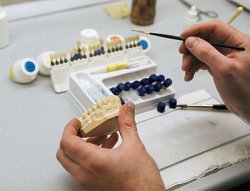
A well-made crown made of cast metal, metal-free ceramics or metal-ceramics lasts at least 10 years. However, it is greatly influenced by the preparation of the root canal for prosthetics. With improper root canal filling, there is a high probability internal inflammation, which can lead to re-prosthetics.
In general, the service life depends on the level of oral hygiene. The guarantee provided for a crown in domestic clinics is on average 1 year. In Germany - 3-5 years.
Crown care
Not to mention standard rules hygiene of the oral cavity, the Stomum portal recommends the use of special devices called irrigators. They produce a pulsating jet of water that thoroughly cleans hard-to-reach spaces.
The result of the installation of crowns will be positive if the doctor indicates everything possible contraindications to their use. Another necessary condition is a necessary preparation of the tooth for prosthetics. And finally, the last factor should be recognized as high-quality manufacturing and installation of the product.
 A dental crown is a non-removable design that allows you to eliminate a defect in the tooth. The anatomical crown of the tooth can be destroyed.
A dental crown is a non-removable design that allows you to eliminate a defect in the tooth. The anatomical crown of the tooth can be destroyed.
In such situations, dental crowns are used to restore the shape, size of the tooth, give the tooth strength, as well as resistance to chewing loads.
They protect the teeth from further decay.
Crowns on abutment teeth can be used to install bridges.
Indications
- Restoration of the tooth crown with its strong destruction (more than 50%).
- Increased abrasion of hard tissues.
- To restore a lost tooth.
- Defects of crowns of teeth.
- Restoration of the anatomical shape and functionality of the tooth.
- Fluorosis.
- Anomalies of the teeth, manifested by the size or incorrect position of the teeth.
- Restoration of the aesthetics of the tooth.
- A crown placed on a crooked tooth will help straighten it.
Contraindications
- Insufficient height of the preserved crown part of the tooth.
- Looseness of the tooth.
- Allergy to dental crowns.
- Malocclusion.
- Periodontal diseases.
- Thinning of the walls of the lower front teeth.
- Age up to 16 years.
Advantages and disadvantages
Advantages of dental crowns:

- Aesthetics.
- Durability and strength depend on the material and method of manufacturing the crown.
- Affordability.
- Cast crowns do not require a strong turning of the teeth.
- White ceramic crowns are ideal for prosthetics of the front teeth.
- Ceramic crowns biocompatible with the tissues of the tooth and gums.
- The installed crown on a dead tooth prolongs its functionality.
Cons of dental crowns:
- Traumatization healthy teeth if they are used for support.
- Depulpation under the crowns on the teeth can cause complications in the form of an inflammatory process.
- Ceramic dental crowns are not strong enough.
- The unaesthetic quality of metal crowns.
Materials for manufacturing
- Modern dentistry offers a wide variety of materials for the manufacture of dental crowns.
- For the manufacture of crowns, metal ceramics, zirconium oxide, metal alloys, ceramics and other modern durable and hypoallergenic materials are used.
- In the manufacture of metal-ceramic crowns, cobalt - chromium and cobalt - nickel alloys are used, as well as alloys precious metals: platinum, palladium, gold.
Types of dental crowns
Types of dental crowns are divided depending on the material used:
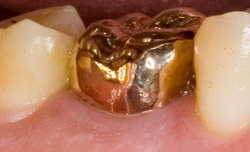
- Metal-ceramic dental crowns. The inner part of the crown consists of a metal frame, which is lined with ceramic on the outside. As a result, the design is characterized by high strength and good aesthetic appearance.
- Dental structures made of non-metal ceramics. These crowns are made entirely of ceramic. The absence of metal improves the aesthetics of dental crowns. Crowns can be made from porcelain or zirconia. Metal-free ceramic structures are very durable, reliable in use and have long term use.
- All-metal dental crowns. They can be solid, stamped, gold. Crowns for molars can be made of metal, because they still do not fall into the smile line. Under such crowns, it is not necessary to sharpen the tooth much.
- Metal composite crowns are combined. They are made from cobalt-chromium alloy, and outer surface lined with plastic. Such crowns are also called metal-plastic.
- Dental crowns on implants.
Which dental crown is best
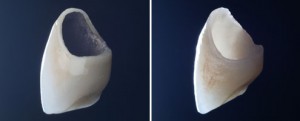
- When choosing the type of dental crown, it is necessary to proceed from the indications for installing the structure, the wishes and choice of the patient, as well as from his financial capacity.
- Metal dental crowns are made from metal alloys, precious metals, or only with their spraying. Metal cast crowns on the teeth restore the chewing function of the tooth. But according to external indicators, these crowns are the most unaesthetic.
- Metal-ceramic dental crowns are characterized by durability and naturalness. At the same time, this type of dental structures is inferior to ceramic crowns. On the positive side, metal-ceramic crowns can be placed on teeth with intact nerves. The downside of the ceramic-metal design is that with the slightest decrease in the gum, a gap is formed between the crown and the tooth, and the metal rim of the dental crown becomes noticeable.
- All-ceramic dental crowns are the closest option to natural teeth. Differ in functional endurance. Ceramics from all the materials described above are highly biocompatible.
How is it made
After preparing the teeth for prosthetics, the following is performed:
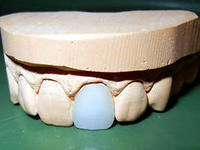
- Removal of casts from both jaws. The impression is made in order to be able to accurately make a crown, taking into account both neighboring and antagonist teeth. For the manufacture of casts, a special impression mass is used.
- In the dental laboratory, a model of teeth is cast from plaster, which is an exact copy of the patient's teeth. On it, a sample of the future dental crown is modeled from wax.
- Temporary crowns are made while permanent crowns are being made. They are fixed on the tooth with a special cement, which allows them to be removed before installing permanent crowns.
- A metal frame of the crown is made, which, after fitting and clarifying the color of the teeth, is covered with ceramics.
Installation steps
To install the structure, it is supposed to prepare the tooth for the crown:
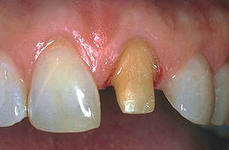
- Visual examination of the tooth with a mandatory referral to X-ray. If necessary, the required treatment and canal filling is carried out.
- To prepare the tooth for the installation of a crown under anesthesia, the tooth is prepared. Grinding of teeth for crowns is carried out taking into account the thickness of the walls of the structure. The walls of the prepared tooth should converge upwards so that the crown can be easily put on the tooth. At the same time, ledges are made in the cervical region of the tooth.
- Depulpation of teeth if necessary. To put crowns on living teeth or dead ones, the specialist decides.
- If top part the tooth is missing, the doctor installs a stump metal tab. It will help to securely fix the crown on the tooth.
- If there is no anatomical crown of the tooth, a pin is placed in the root of the tooth.
- Taking impressions, which are then sent to the dental laboratory by the doctor.
- An example of the finished design. Color selection.
- Fixation of the crown on the tooth with permanent or temporary cement (at the discretion of the doctor).
How is a dental crown different from a filling?
A dental crown and filling is used to restore the shape and appearance of a tooth.
Their difference:
- Tooth filling takes place directly in the patient's mouth. The filling is attached to the walls of the tooth. She acts as a wedge. When pressure is applied to the filling, it puts pressure on the walls of the tooth and can cause it to fracture. A large amount of filling increases the likelihood of a tooth fracture.
- The dental crown covers the tooth from above, so the tooth under the crown remains intact, even with strong pressure on it. The crown is made in the laboratory.
Video: "Restoration of the crown of the tooth with a filling"
Benefits of a dental crown:
- The material from which the crown is made is much stronger than that from which the seals are made.
- The crown is less likely to break. If the crown is de-cemented or broken, it is possible to repair the dental crowns or replace the tooth crown. When filling, this option is not possible.
- The crown transmits chewing pressure to the root. A filling - on the remaining parts of the tooth, which can provoke a fracture.
For high-quality restoration of the tooth, the following rule should be followed:
To restore a tooth with a filling, the defect should be no more than 1/3 of the volume of the remaining tooth. If the defect is 1/2 - 1/3, then the restoration is carried out with an inlay or veneer. With the destruction of the dental crown by more than 50% - the most effective method restoration of the tooth - crown.
Service life of dental crowns
The service life of dental crowns depends on factors: the material from which the crown is made, the quality of the construction, the care of the prosthesis, the condition of the gums.
- Metal crowns have a service life of 25 years or more.
- Metal-ceramic crowns - 10-12 years.
- Metal-free structures have less use - from 5 to 10 years.
Often the crown has to be removed not because of its wear, but because of problems with the tooth under the crown. The reason may be poor preparation of the tooth for prosthetics.
A year - one and a half after prosthetics, when the guarantee for dental crowns ends - often manifests itself chronic inflammation in the area of the tooth root, which is characterized by swelling and soreness of the gums, may appear bad smell from under the crown of the tooth.
The lifespan of crowns is affected by oral care.
Care
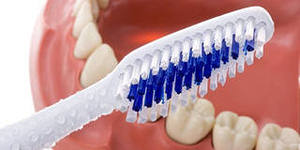
- The same as for real teeth. It is advisable to visit a dentist at least once every six months to check the condition of the structure and surrounding tissues.
- If single crowns are installed in the mouth, then they can be cleaned with a toothbrush with paste and floss.
- If there is a bridge in the oral cavity, irrigators are recommended for irrigating the structure. Thus, food residues and soft plaque are removed from hard-to-reach places.
FAQ
- Question: The doctor suggests putting crowns on the teeth. Is it bad for a tooth to grind?
Answer: Turning is a traumatic procedure for the tooth. It is a necessary step in the preparation of a tooth for a crown.
- Question: How much does a ceramic-metal crown cost?
Answer: The cost depends on how much and what kind of metal will be used. Depending on this, such a crown will cost from 3 to 40 thousand rubles.
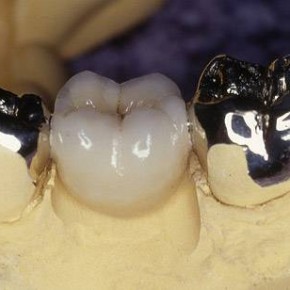
Answer: A ceramic crown looks just like a real tooth. It is better to put a metal-ceramic or metal crown on chewing teeth, because they are more durable.
- Question: How are dental crowns glued to the tooth?
Answer: To glue crowns, dental cement or special glue for dental crowns is used.
- Question: Do teeth deteriorate under a crown?
Answer: If the preparation for the installation of the crown is carried out qualitatively, then the teeth under the crown cannot deteriorate. After all, a crown is put on a tooth in order to preserve it.
- Question: How to clean dental crowns?
Answer: Crowns should be cleaned in the same way as all other teeth with a toothbrush and toothpaste and floss.
- Question: Can there be any complications after installing a crown on the teeth?
Answer: If a high-quality preparation of the tooth was carried out before installing the crown, then there should be no complications.
Prices for dental crowns
The cost of a crown per tooth depends on the material and method of its manufacture.
More expensive porcelain crowns are usually recommended for use only on the anterior teeth, therefore, in order to save money, cheaper crowns, such as porcelain-fused-to-metal crowns, can be placed on posterior teeth.
Photos before and after the installation of dental crowns
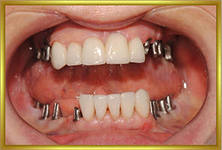 |
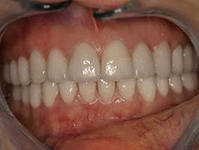 |
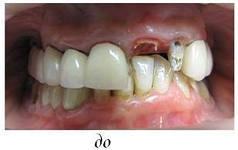 |
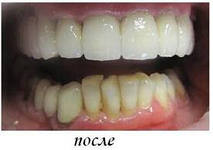 |
 |
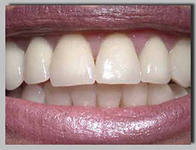 |
Video: “Metal-ceramic crowns. Some Features »
Dentistry now offers more options than ever before when it comes to restoring teeth. Improvements in the beauty, strength and durability of materials such as porcelain and zirconia have made cosmetic restorations more natural and lifelike than some of the the best materials used 10 or 15 years ago. Therefore, the question arises which dental crowns are better to choose.
But not every tooth or diseased tooth is best treated starting with full recovery porcelain. There are many more reasons to use another material such as gold, or even composite materials, they may be the best choice for you.
There is no single type of crown that is the best solution for all dental situations. Before making a decision, look at all types of crowns. This will help you make right choice which best suits your needs and circumstances.
Let's take a look at the pros and cons of the latest materials available for crowns and bridges. But first, let's find out the definition of the word crown.
The term "crown" refers to one of two definitions:
- In general dental anatomy, this is the part of the tooth that is covered in enamel and is visible in the mouth. Root - another part of the tooth that holds the tooth at the mouth of its attachment to the periodontium and jawbone. The demarcation line between the crown and the root is called the cement node.
- In restorative dentistry, a crown is a restoration that covers the anatomical crown of a tooth to restore its normal shape and function.
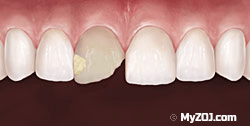 |
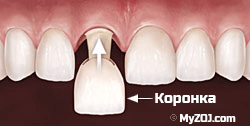 |
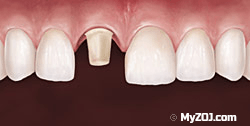 |
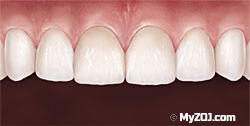 |
Types of dental crowns
Crowns are made from various kinds materials. Depending on the tooth in need of a crown, your dentist will suggest a material, or combination of materials, that is best for you and your situation.
Temporary crowns.
These mainly include plastic crowns, which I use temporarily, usually during the production of dental crowns in the clinic. Can be done on the "knee" at the dentist's office. They are also used for the aesthetic aspect, because no one wants to show their smile without teeth.
Plastic permanent crowns.
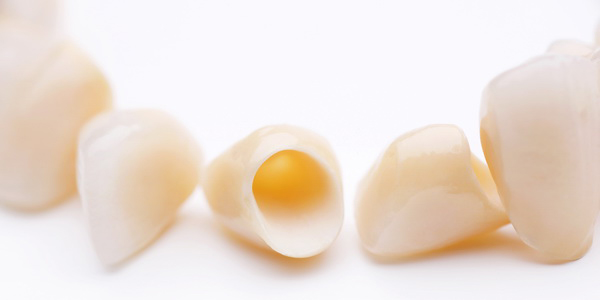
They are cheaply made, but as you know, plastic is harmful, especially when heated. She starts to highlight harmful substances. We advise you to choose others.
There are the following types of alloys: gold, palladium, nickel or chromium. Compared to other types of crowns, their structure is subject to less wear from opposing teeth and is kept to a minimum of damage. Metal crowns withstand strong bites and chewing. The advantage of metal crowns is that they rarely break. The big downside is their color. Metal crowns a good choice for molars. (joke =))
golden crowns are made from gold. They usually serve for a long time and will not break or collapse. In addition, they do not crack or break. However, the golden color does not look natural, especially on the front teeth.
Composite crowns look natural. They won't break as easily, but they tend to wear out faster from chewing. Brushing your teeth will generally remove the polished surface of composite crowns and this will cause them to wear more easily.
Porcelain crowns look most natural, like normal teeth. They are more brittle than metal or composite and can break off easily. Because of this, they are not usually placed on back teeth. In addition, to make them more durable, it will be necessary to sharpen the tooth strongly.
Porcelain crowns with metal They look natural and are stronger than simple porcelain or composite crowns. They will not break as easily as porcelain or ceramic crowns. However, it all depends on their metal construction. They mainly use porcelain crowns with gold, which are based on a gold crown covered with porcelain.
Pluses in strength, and double protection of the tooth in case of cracks or breakage. Cons in not the penetration of light through them. Porcelain crowns with zirconium base are similar to gold base, but better than those with gold base.
Metal-ceramic crowns are made of ceramic-coated metal. The metal base for the crown can be obtained from various metals and alloys - this is exactly what makes them very durable. We already wrote about this in the previous paragraph.
Ceramic crowns will provide you with a better natural tooth color than any other types of crowns. They are more suitable for people with metal allergies. However, they are not as strong as porcelain merged with metal. Ceramic crowns are a good choice for anterior teeth.
They are made from more thin material which makes them lighter. Plus, the material used is "biocompatible", it is a kind of analogue of natural gum tissue and allows them to grow along with the crown.
Porcelain crowns are made from pure ceramic and no other materials, unlike other crowns that are made from alloys with metals. This usually allows you to make a translucent material that has an attractive appearance and blends well with natural teeth. This type of crown can last for several years.
Despite the advantages of these crowns, it would be fair to highlight the disadvantages. There is a trade-off between aesthetics and durability: this type of crown is realistic and pleasing to look at, but there is also back side. They are less durable than other types of crowns and are more prone to cracking and breaking.
Zirconia crowns
Zirconium is becoming one of the most popular materials for dental crowns.
Its advantages:
- Extremely durable.
- Withstands wear and tear for a long time.
- Fairly transparent and similar to natural teeth.
- Less tooth wear.
- Does not contain metal.
- You can set the size, shape and color.
- Biocompatible.
Zirconium is a type of durable crystal and is indestructible.
Plus there is no fear that the body will reject zirconium or appear allergic reaction on him. It is safe to use and is preferred by many people.
permanent crowns made of stainless steel of all metals (for example, gold, zirconium or any other alloys). Then covered with porcelain or ceramics. They are made in a dental laboratory using special equipment.
What else do I need to know?
Crowns are strong and usually last for about 10 years or more if you take good care of them. Brush your natural teeth daily. Crowns may not be as strong as natural teeth.
Installation of dental crowns
If one tooth is missing, crowns are placed on the neighboring ones, there will be a bridge in the middle. On the first day, you are examined, if necessary, sanitation is done if the teeth are in good condition: never been treated and never bothered you, and not elongated, (so as not to grind too much) in this case, a crown is placed on a living tooth.
You can see it visually in the video below.
When should a crown be placed on a tooth?
- If the tooth is damaged and protection from destruction is needed.
- If you need to restore a broken tooth.
- If you need to build a bridge.
- If necessary, cover a dental implant.
How much does a dental crown cost
As always, when considering any dental treatment and the question of which crowns are best for you to choose, the most important conversation will be your conversation with the dentist who will carry out your treatment. This article is only intended to help you better understand the main pros and cons of the most tested and accepted crown materials at present.
Each individual patient may have specific health conditions or anatomical findings that may have a greater impact on treatment decisions than any of the information provided here.
Remember that all types of dental crowns have the potential to break and may need to be re-fortified or replaced from time to time. Any tooth that has been crowned may also still be decaying and in need of repair. necessary treatment root canal.
We encourage you to get as much information as possible about your dental treatment options as you see fit, and then discuss this information about your dental condition in a specific meeting with your dentist.
If the teeth are severely damaged, then crowns will help restore their appearance and function. Chewing teeth such designs will return the normal ability to chew food. A high-quality crown replaces a real tooth if you make the right choice. What design options are preferable to put on chewing teeth? What should patients know about their choice?
About the choice of structures
The chewing group of teeth is the beginning of the digestive system. Their function is important in that they grind food. For this reason, the loss or damage of one of the elements of the chewing system necessitates its prompt restoration in order to avoid deterioration in the quality of chewing food. Crowns allow you to save tissue from complete destruction, reliably restore the function of chewing.
The patient and the doctor must take into account a number of conditions before choosing the material for the manufacture of the structure. So, for example, to save from further destruction of the chewing organ, you can apply.
If the walls of the teeth are thin and can break during turning, then it is more expedient to opt for cermets. Then the load will be distributed on the metal frame, and this will protect the tooth from destruction.
If the patient is limited in finances, the specialist can offer him a metal structure. These crowns are durable and very reliable.
Characteristics of crowns
To save chewing teeth, specialists put single crowns or bridges. Learn about the advantages and disadvantages different types such structures:
- Metal. They are in most cases installed on those teeth that wear out. The advantages of the structures are that they are durable, strong - their service life is more than 10 years; no need to grind hard tissues chewing organ, in contrast to. As for the shortcomings, the main one is not quite an aesthetic appearance. For most, it is this minus that is an obstacle to the choice of metal structures. Although, in fact, on chewing teeth, such a disadvantage is not so visible.
- Metal ceramics. The main advantage of this design is durability. It is achieved thanks to the metal frame. Equally important is the natural and aesthetic appearance of the structure, since it is covered with ceramic cladding. Such options have a significant drawback - the need to grind off a large amount of hard tissue before installation. The frame of such products can be made of gold, chromium, cobalt, nickel, platinum. Often, in addition to pure metals, alloys are used, for example, nickel + chromium or cobalt + chromium. They have good compatibility with oral tissues and are affordable. Ceramics are applied in layers on a metal frame. In a special oven high temperature the product is fired after applying each layer. This is how it is created reliable connection between metal and ceramics.
- Metal-free ceramics- highly aesthetic, durable, reliable material. Its main feature is that it transmits light, because metal is not used in the manufacture. It is because of this that a metal-free crown is almost impossible to distinguish from a natural tooth. However, the main disadvantage of such products is the high cost. Therefore, in most cases, such structures are placed on the front teeth, which are always in sight. And chewing is covered with other types of structures. Metal-free structures are made of porcelain, ceramics, zirconium dioxide. Plastic crowns are a budget and popular option. They may be temporary. Porcelain variants are used for single prosthetics. They are durable, with good aesthetic performance.
- Combined crowns. The method is used when there is a need to restore chewing teeth and those that are nearby, in the smile zone. Then expensive materials are used for the latter, and metal is used for chewing teeth.


